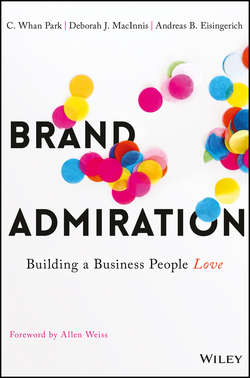Читать книгу Brand Admiration - Weiss Allen M. - Страница 8
На сайте Литреса книга снята с продажи.
SECTION 1
THE BIG PICTURE
Chapter 1
Why Brand Admiration?
Introduction
ОглавлениеYes, we have heard about it and seen it with our own eyes, but it is still hard to fully grasp Apple’s miraculous comeback during the first 16 years of the 21st century. In 1999, Microsoft’s stock was at a record high, with its market capitalization close to $620 billion. Apple was teetering on bankruptcy. The notion that Apple would ever match Microsoft’s financial firepower, let alone surpass it, was unthinkable. In a 1998 Vanity Fair interview, Bill Gates “couldn’t imagine a situation in which Apple would ever be bigger and more profitable than Microsoft.” Nearly 17 years later, Apple’s market capitalization stands at $683 billion, more than double that of Microsoft’s. Sales of the iPhone 6s have been phenomenal, and more than 48 million iPhone 6 and 6s units were sold during the last quarter of 2015 alone.1 Indeed, in July of 2015 Microsoft’s chief executive Satya Nadelia stated that if Microsoft is to compete with Apple, Google, and others, Windows must become desired. Microsoft’s Windows operating system has endured as a must-have work tool, not because it’s an object that customers love. From his perspective, making customers love Windows was the critical objective.2
We don’t know what will happen to Apple five or 20 years from now. But the answers to two important questions might help Apple strengthen its success over time. The first asks how Apple turned itself around. The second asks what Apple must do to ensure continuous growth and prosperity. As to the first question, we’ve heard a lot about the things that Apple did right when it introduced the iMac, iPod, and iPhone. However, we do not understand how these and other factors created the powerful Apple brand. Knowing a list of factors is one thing. Understanding how they work together to produce such a strong impact on customers is another. Unless we can answer the first question, it is hard to answer the second.
Microsoft needs to ask why it failed to make people love Windows, despite its must-have usefulness. It also needs to ask whether creating brand love is the ultimate and true destination point to which Microsoft should aspire. We think the answer is no. While important for developing prosperous customer relationships, love alone is limited in its power to sustain customer relationships over time. To create prosperous and sustainable customer relationships, Windows needs to go beyond brand love. Like the world’s most successful brands, it needs to become admired. A fundamental goal of this book is to discuss what admired brands are, how to develop them, how to strengthen them, and how to leverage them over time so that they reap maximal benefits for customers and the company alike. Why does this matter? Let’s explore the brand’s value to companies and customers alike.
1
Sarah Buhr, “48 Million in iPhone Sales Leads Apple’s Q4 2015 Earnings,” TechCrunch, October 27, 2015, www.techcrunch.com/2015/10/27/48-million-in-iphone-sales-leads-apples-q4-2015-earnings.
2
James B. Stewart, “How, and Why, Apple Overtook Microsoft,” New York Times, January 29, 2015, www.nytimes.com/2015/01/30/business/how-and-why-apple-overtook-microsoft.html?_r=0.
